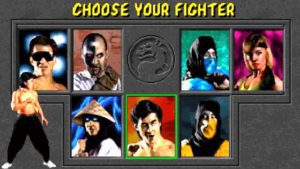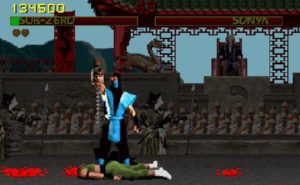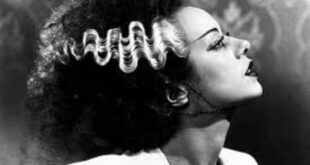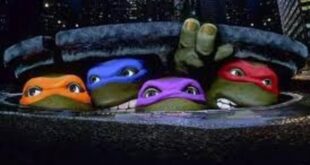Its 1992 and you’re 6 years old. You are a video game fan most notably the Nintendo Entertainment System and the new fangled Super Nintendo Entertainment System. The graphics are primitive with unrealistic 8 or 16 bit sprites. Even arcade games which were graphically superior still displays cartoon-esque images. The games at the time are child friendly and can be enjoyed by anyone. You stop by the Ninja Turtles game, then The Simpsons, maybe some pinball machines. There’s also a fighting game that came out recently known as Street Fighter 2 that displays hand to hand fighting but toned down for the kids. All of a sudden you stop dead in your tracks as your eye catches something you’ve never seen. A brand new arcade game with a huge dragon on the side of it. The title says Mortal Kombat. You wonder what this is as you see an adult playing it, not a child like yourself. You peek over and you see a ninja in blue that looks like a real human battling with another human that kind of looks like Jean Claude Van Damme. The action is slower paced than Street Fighter 2 but looks real. The man playing as the ninja wins the fight but the screen says FINISH HIM! Your jaw drops as well as the quarter you were holding as the ninja literally rips off the head with the spine still attached of his opponent with the blood pouring out. The era of the horror game had begun.
Ed Boon of the company Midway was the architect and grandfather of Mortal Kombat so to speak. In 1991 he was tasked with making a fighting game that could rival Street Fighter 2’s popularity. He had only 3 others with him during production of the game. Artists John Tobias and John Vogel along with sound engineer Dan Forden. That’s right, not counting company execs and the actors in the game there were only FOUR people working on the original Mortal Kombat. Boon took a look at a fighting game that came out a few years earlier named Pit Fighter that used rotoscoped background over digitized human choreographed motion capture, and wanted to do something similar yet more fine tuned. Pit Fighter was considered choppy with butchered controls so Boon wanted a game more simplistic. John Vogel was a big fan of the old arcade game Karate Champ (which makes an appearance in the movie Bloodsport) and how it was a one on one match with no outside interference. Boon also was a big fan of the legendary fighting movies Enter The Dragon and Bloodsport, so he wanted to create a game similar to that. Not only that, he wanted Jean Claude Van Damme himself to be apart of it! He was going to create an Enter the Dragon type tournament run by a crooked crook with Jean Claude Van Damme playing the lead character. The problem was licensing, at the time Van Damme was working on the movie Universal Solider. Midway couldn’t license JCVD so Boon had to go to plan B, create a character exactly like Jean Claude. That’s how Johnny Cage was born, almost an exact clone of JCVD with his own personality thrown in.

Speaking of characters, this is how Mortal Kombat was different from everyone else. In every other fighting game, every character was a clear cut hero or villain almost. Even the villains weren’t that scary or that nefarious. Of the 3 main villains of the game Street Fighter 2, two of which were an ex-boxer and the former tournament champion. Then Mortal Kombat came along and blew the industry away with conventional characters going right out the window. The goal of Street Fighter 2 was to defeat the two main villains Sagat and M.Bison in the tournament. Every character had different endings but that was the end goal, win the whole thing. Mortal Kombat, on the other hand, delved deeper into each character with their own separate endings. The character Scorpion wasn’t even human, he was a resurrected ghost of a slain assassin that entered the tournament to find and take revenge on his killer, another character named Sub-Zero. Sub-Zero was written to be an assassin that was paid a large sum of money to win the tournament and kill the host, the evil Shang Tseung. So in other games you had characters such as ex-pro wrestler Buzz in Pit Fighter, sumo wrestler E. Honda in Street Fighter and the karate guys from Karate Champ that are there to win fights. In Mortal Kombat you have a guy who makes a living murdering people on a mission to murder the host while an assassin from a rival clan he’s already killed comes back from the dead to try to murder him. Not exactly family friendly storytime is it? Remember how I said most characters were clear cut fan favorites trying to stop the bad guys? Well only two of the chosen 7 is as such, one of which is the only female in the game Sonya Blade. Her background is she’s a special forces commando who’s team was slaughtered by a notorious gangster named Kano and she must enter the tournament because he will be there too. Kano himself is one of the 7 playable characters and his character is just that, an evil, murderous gangster. Between the two assassins and now this guy, you can play as three murderers. Then again even if the targets are bad guys, you can argue Sonya is a murderer too being in the special forces. Then you have the wild card, Raiden. Raiden is a legitimate God of electricity that’s taken human form to compete in Shang Tseung’s tournament just for kicks. His character in later games was later changed to what we know today, but that was the original Raiden bio. As a God, he has the ability and means to murder as well. The only one of the 7 characters that doesn’t kill is the eventual series hero, Liu Kang. If Johnny Cage was based off Jean Claude Van Damme, Liu Kang is a direct ripoff of the late martial arts master Bruce Lee. He’s wearing the same outfit Bruce did in Enter The Dragon and his shouts and grunts are the exact same. Liu’s background is Shang Tseung took over the tournament 500 years ago from the Shaolin and he’s the chosen one to win it back. So of the seven playable characters you have a murderous thug, two assassins, a special forces hero, a martial arts actor, a Shaolin monk and a thunder God. You know how I mentioned the boss fights of other game were against tournament champions and henchmen? Meet Goro….the sub-boss. A 500 year old half-human, half-dragon with four arms. Goro has become a cult favorite in the 25 years since the original game but that’s who you had to face before the final battle against Shang Tseung. Goro was a killer and so was Shang Tseung as well.

In the words of Sgt Apone “Ahhhhhh, absoloutely BAD ASSES!”
With so many murderers written into the game, obviously murder became part of it. If you landed enough consecutive hits in Street Fighter, your opponent would be “dazed” and you could land a few more free hits. Ed Boon figured that’s a little cheap and decided on waiting until the very end of the fight once its been decided to get the free hit in. Its become iconic but at the end of the fight, Shang Tseung would shout “FINISH HIM/HER!!” and that’s where you can knock your opponent out or perform a Fatality for extra points. Remember in the intro I said a ninja in blue ripped Jean Claude Van Damme’s head and spine off? That was Sub-Zero’s fatality. Sonya would blow a pink kiss that fried her opponent to a crispy skeleton, which was similar to Scorpion who would pull off his mask revealing a skeleton head only to blow a fireball to fry the opponent. Johnny Cage would uppercut his opponent’s head clean off and Raiden would use his electricity to explode the head off his opponent. Kano would literally rip the heart out of his opponent and show it and Liu Kang….had no fatality. Technically he performed a cartwheel kick and uppercut to be credited for a Fatality, but his character was written as a Shaolin monk. Th Shaolin have a strict rule, no killing. Fans thought it was weak but it was realistic. If that wasn’t enough to scare the crap out of kids, there was one more chill up the spine. In the game there were beautifully detailed stages that the characters fought on. One was in front of spectators, another in a palace with Shang Tseung watching. Then there’s “The Pit”. The Pit was a long platform where once the fight was over, you could knock your opponent off into a bed of spikes. Once your opponent became impaled, you saw the severed heads of the design team also impaled on various spikes. Once again, realistic violence was the key. Every other game had animated graphics so no matter how violent a game got, you could look at it like a cartoon. Not Mortal Kombat. Their fully digitized graphics of actors and martial artists being impaled, dismembered or burned alive left a fresh image in the minds of whoever played it for the first time, especially in 1992 when there were no other games that were like that.

Not exactly Super Mario is it?
So after all that, the game was released to arcades where it was a smash hit. It became a worldwide phenomenon because it hit on all demographics. Kids weren’t supposed to play it but did anyway, rebelling teens that wanted something new loved it, and adults that weren’t into “kiddie games” enjoyed ripping hearts and spines out. Ironically it almost took a whole year for the usual liberals and hysterical parents to start complaining. Even though Mortal Kombat was in the arcades in 1992, it wasn’t released onto home consoles such as Sega Genesis and Super Nintendo until September 13, 1993 dubbed “Mortal Monday”. An official hearing launched by Senators Joseph Lieberman and Herb Kohl was to determine, get this, whether violent video games were corrupting society. Yes, not easily accessible R rated movies, not daily shootings in South Central LA, not the Unabomber…but Mortal Kombat was the downfall of society in 1993. What this led to was the Entertainment Software Ratings Board being created to rate games based on their graphic level. At that point, apart from Atari Porn (another story for another day), no games came even close to Mortal Kombat to warrant a teen and up rating. The floodgates were opened and soon Robocop Vs Terminator and a Beavis & Butthead were released with an MA-13 rating. Mortal Kombat 2 was in production as well and it too got its customary MA-13 rating upon its future release.

“No more fun of any kind!!”
The legacy for the game has been almost unmatched. The series has spanned 10 full games along with 3 spinoff games in the 25 years since the first one was released. In the past 7 years Mortal Kombat has teamed up with DC comics to create a crossover game Mortal Kombat Vs DC Universe and Mortal Kombat characters were featured in DC’s Injustice series. The first Mortal Kombat game was rated the number 1 in a list of best fighting games of the 1990’s by Complex.com in 2013. Forbes magazine said that the game has been so popular that original arcade cabinets are worth as much as $2,500 apiece even to this day. As Mortal Kombat kept reinventing itself, changing with the times, introducing new characters and storylines, the original game still holds up 25 years later. Mortal Kombat 10 was released in 2015 and from the first to the latest, all the games have one thing in common, they’re all fun. Also they have added the horror element to their games Mortal Kombat 9 featured none other than Freddy Krueger while Mortal Kombat 10 had the Xenomorph, the Predator, Leatherface and Jason Voorhees. So let’s all test our might, finish him or her and shout “MORTAL KOMBAT!” in honor of the 25th anniversary of the debut of arguably the greatest fighting series of all time. Mortal Kombat wins…flawless victory.
 PopHorror Let's Get Scared
PopHorror Let's Get Scared



